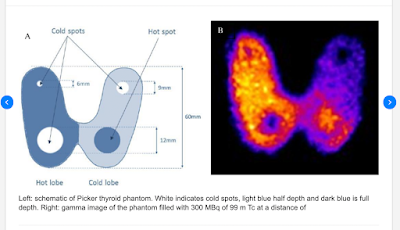What is nuclear medicine?
Nuclear medicine is a specialized area of radiology that uses very small amounts of radioactive materials, or radiopharmaceuticals, to examine organ function and structure. Nuclear medicine imaging is a combination of many different disciplines. These include chemistry, physics, mathematics, computer technology, and medicine. This branch of radiology is often used to help diagnose and treat abnormalities very early in the progression of a disease, such as thyroid cancer.
Nuclear medicine determines how the body is functioning at a cellular level. It is able to:
- find disease in its earliest stages
- target treatment to specific cells
- monitor response to treatment.
Because X-rays pass through soft tissue, such as intestines, muscles, and blood vessels, these tissues are difficult to visualize on a standard X-ray, unless a contrast agent is used. This allows the tissue to be seen more clearly. Nuclear imaging enables visualization of organ and tissue structure as well as function. The extent to which a radiopharmaceutical is absorbed, or "taken up," by a particular organ or tissue may indicate the level of function of the organ or tissue being studied. Thus, diagnostic X-rays are used primarily to study anatomy. Nuclear imaging is used to study organ and tissue function.
Nuclear medicine tests use a small amount of radioactive material combined with a carrier molecule. This compound is called a radiotracer. These tests help diagnose and assess medical conditions. They are non-invasive and usually painless.
When a radiotracer is injected into the body, it builds up in certain areas of the body. Radiotracers go to the area of the body that needs to be examined, such as a cancerous tumor or inflamed area. They can also bind to certain proteins in the body.
The areas where the radionuclide collects in greater amounts are called "hot spots." The areas that do not absorb the radionuclide and appear less bright on the scan image are referred to as "cold spots."

Tidak ada komentar:
Posting Komentar